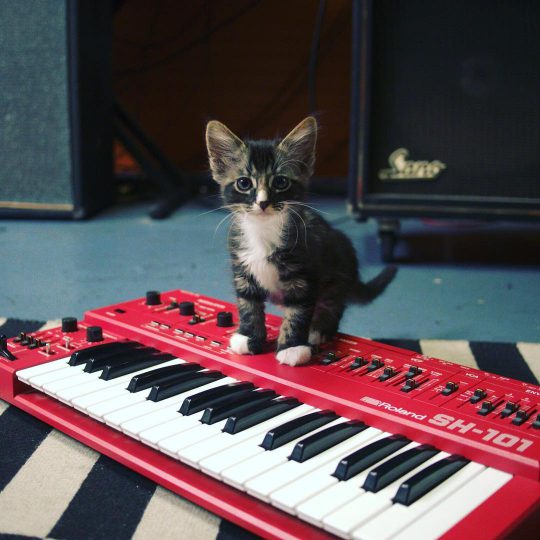
Adorable kitten sitting atop a red Roland SH-101 synthesizer. From the Vintage Synthesizer Museum.
This cat wants to remind you that VSM is offering a hands-on Intro to Synthesis workshop on September 22nd. Contact us for details or to enroll.


Adorable kitten sitting atop a red Roland SH-101 synthesizer. From the Vintage Synthesizer Museum.
This cat wants to remind you that VSM is offering a hands-on Intro to Synthesis workshop on September 22nd. Contact us for details or to enroll.
Meet “DJ Pearl”, an adorable foster kitten who lives with Shadow and Brodie (whom we met a few weeks ago). She even has the same affinity for playing the M-Audio Axiom keyboard as Shadow. Submitted by Anne Corwin via our Facebook page.
Introducing Shadow’s tiny assistant, foster kitten DJ PEARL! She is ready to rock…and looking for her forever family!
Pearl seems so sweet and charming, and we suspect she will end up as a “foster fail” 😻
https://www.facebook.com/anne.corwin.7/videos/10156408542318618/
After several years, we at CatSynth are resuming our tradition of sharing wild cats on earth day. Those who follow our Facebook page are regularly treated to photos and videos of wild cats. We share a few favorites, along with some of our own.
A personal favorite of ours is the fishing cat (Prionailurus viverrinus). It is unique in that is adapted for swimming and hunting in the water. The sleek fur, streamlined shape, and folded ears attest to this adaptation.
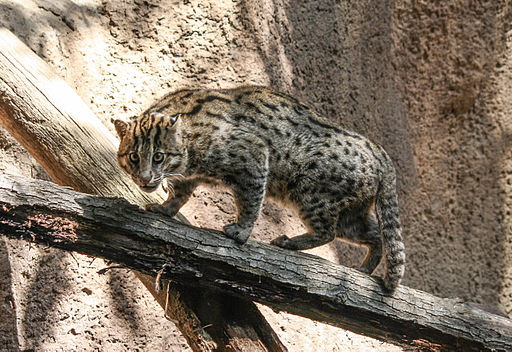
[By Bernard Gagnon [CC BY-SA 3.0 or GFDL], from Wikimedia Commons]
The fishing cat has discontinuous populations in rainforests of South Asia and Southeast Asia. It is listed as Vulnerable, primarily due to habitat destruction. The Greensboro Science Center in Greensboro, North Carolina, recently posted this video featuring a mother fishing cat teaching her kitten their aquatic heritage.
Another lesser-known cat is the oncilla (Leopardus tigrinus). It is among the smallest of wild cats, similar in appearance to but significantly smaller than the well-known ocelot.
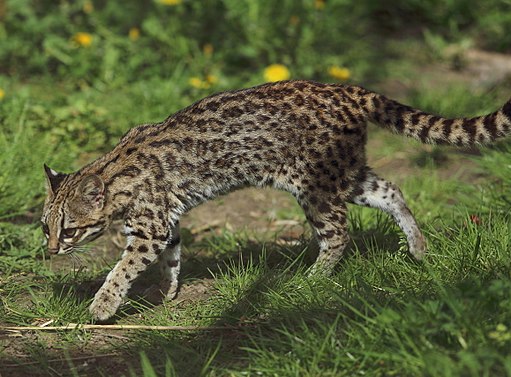
[By Groumfy69 [CC BY-SA 3.0], from Wikimedia Commons]
The oncilla lives throughout Brazil as well as the highland tropical forests of Colombia, Ecuador, and Peru. There is even a recorded separate population in Panama. It is listed as Vulnerable in IUCN classification, mainly due (once again) to habit loss.
Both of these cats and many others have a similar spotted look that works well in their forested environments. Our old pal the Pallas cat (Otocolobus manul), also known as the manul, is quite a different beast altogether. It has a squat shape, fluffy fur and a gray color that are suited to its cold rocky environment in Central Asia. Here is a manual I encountered at the Prospect Park Zoo in New York some years ago.
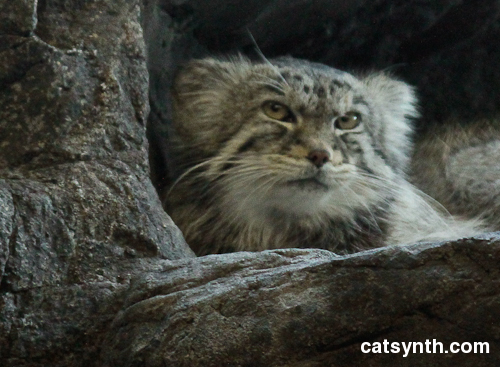
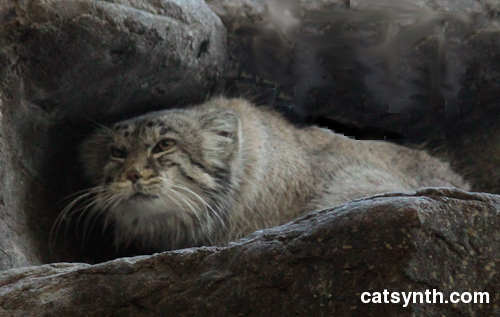
More recently, we attended the Feline NightLife at the California Academy of Sciences, and got to see many wild cats courtesy of Safari West, including this beautiful serval.
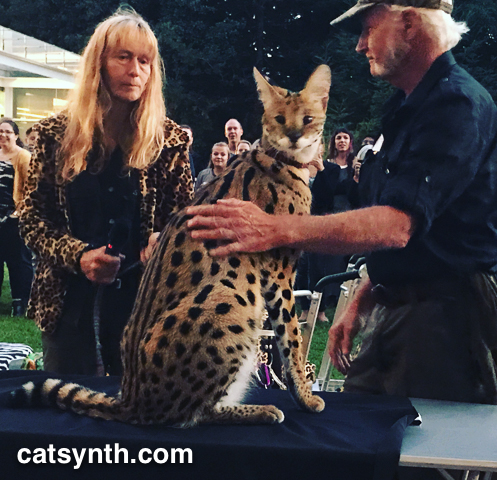
While not endangered, servals have been frequently been captured and bred as exotic pets. They do, however, remain wild predators and their domestic captivity usually goes badly for human and feline alike. As our host from Safari West said, “they do not make good pets, but they will eat good pets.” Below is a “cat” that actually is not a cat at all, but a separate genus, the genet. If they had not told me, I might have guessed it was a fishing cat.
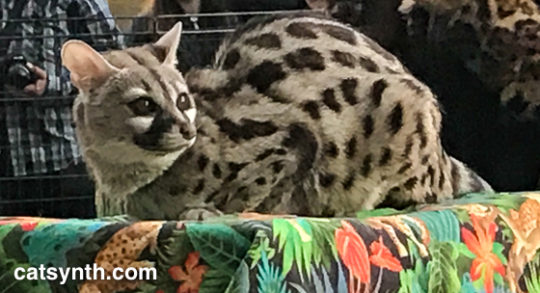
Sadly, Safari West was affected by last year’s devastating Tubbs fire in Sonoma County. Several structures burned, and the co-founders lost their own home. Fortunately, most of the property was spared and the animals all made it through the conflagration safely, and Safari West reopened for tours and programs in late November. You can read more about their experience (and find out how to support them) here.
We conclude with our friends at ISEC Canada, an organization dedicated entirely to the conservation of small wild cats. They have many projects underway, including a study of the black-footed cat, another lesser-known small wild cat from southern Africa. It’s esimated range covers parts of Namibia, Botswana and South Africa.
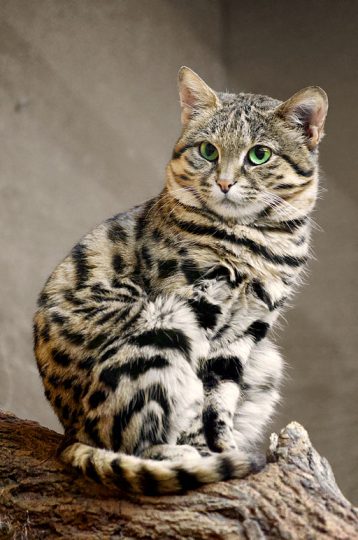
[By Patrick Ch. Apfeld, derivative editing by Poke2001 [CC BY 3.0], from Wikimedia Commons]
The black-footed cat is adorable, and its face closely resembles many housecats. But once again, this is a wild animal and does not belong in a domestic setting. We applaud the work of ISEC Canada and other organizations who study and help to preserve them in their wild habitats.

Kisses the kitten explores a modular synth setup. We think kisses is adorable 😻
By our friend Julia Moore, aka Portland-based multi-instrumentalist Juli Amore. Please do check out her music.

Adorable black kitten with a Moog Mother-32 synthesizer.
From our friends at Moog Music, Inc. Also via matrixsynth.
“Oscillate-purr….#mother32”
We opened this year’s NAMM coverage with a visit to the embarrassment of riches among modular synths at Booth 5000, so it is feeding that we return there for our final article. You can read the first installment (with a separate article devoted to the new offerings from Rossum Electro-Music).
We at CatSynth are fans of Make Noise Music and their modules. This year they introduced the TEMPI.

The TEMPI is a “six channel, polyphonic time-shifting clock module” that allows to create and store clock-signal arrangements using both algorithmic and manual techniques. The channels can be linked to do classic clock-divider and multiplier patterns, as well as manual entry. The divider/multiplier are continuous so can go beyond integer ratios. And it has storage for 64 6-clock configurations. I often complain about my current lack of clock sources (especially for driving the Make Noise Rene), so this would be a potential great addition.
Make Noise also released standalone synth, the 0-Coast.

Like the offerings from many manufacturers this year, the 0-coast is intended to be an integrated full synthesizer voice, complete with CV and MIDI control. As one would expect, it’s a bit more esoteric than the equivalents from Roland and Moog. The parameters remind me a bit more of a Serge or Buchla synth.
Pittsburgh Modular also released a new standalone modular system, Lifeforms.

The Lifeforms is a single-voice unit with oscillator and Pittsburgh Modular filter plus integrated controls. It can be paired KB-1 pressure-sensitive controller to make a fully autonomous instrument. You can here a bit of my attempt to play it in this video.
The Lifeforms does seem like a rebrand. While the sound character reminds of me of existing Pittsburgh Modular synths and it retains the iconic knobs, the stenciling on the faceplates is different – the old “typewriter” look of previous modules has been replaced with a more contemporary style. The system would make a good entry to more advanced modular synthesis.
Endorphines was presenting their own colorful line of modules.

The heart of their system is the Furthrrrr Generator, a complex VCO reminiscent of Buchla synthesizers with its simple functions based on harmonic relationships. Similarly, the Fourierrrr module provides waveshaping using harmonic relationships. These are complemented by a serious of function and control modules, including the Shuttle Control that converts between USB, MIDI and CV. You can hear a bit of fun with their modules in this video featuring our little mascot.
WMD presented the new Aperture Filter, a full-module version of their existing Aperture Filter card for Black Market Modular’s ColourCV system.
It is described as “a variable width bandpass Butterworth filter (designed by Tyler Thompson).” You can hear a bit of this filter, along with WMD’s new Performance Mixer.
We conclude with the Haken Continuum, which was on display amonst the modular madness. Not a new instrument by any means, but one that is always fun to return and play. The control surface feels liquidy and comfortable, but familiar enough for an experienced pianist.

The demo included an iPad synth with a string patch that took advantage of the Continuum’s multi-dimensional degrees of freedom. But sitting among the modular synths, one can contemplate other possibilities. To this end, Haken has introduced the CVC that allows direct analog CV control from the fingerboard without the need for a MIDI converter.
There really was a lot at the show that I couldn’t get to, or did not fit into an article. It can always be a bit overwhelming, but very rewarding. In the end, NAMM visits are always a mixture of wanting the new instruments I see, and reaffirming things I wanted from previous years. I will be working on my list…
From peff on SoundCloud, via matrixsynth.
Dave Smith Instruments Prophet 6 program and sequence demos.
level and balance test 6dB headroom (-6dBFS)
ref: Prophet6-kurt_k-051315.syxOS6
The Prophet 6 is quite a synth. The cat seems to agree 🙂